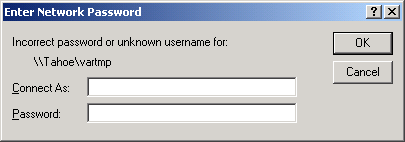
|
|||||
Start | Settings | Control Panel | Users And Passwords
Start | Settings | Control Panel | Users And Passwords | Advanced | Advanced User Management | Users
Having access means being able to login as that user, and not get one of these dialogs when you try to browse over to the network disk:

To prevent that, make sure your disk server has that user configured with a correct password, or open the share permissions until you can login as the user, and access the server without getting that error.
If you're disk server supplies its disks via Samba, you can open the permissions to the disk (note green text):
# Disk entry excerpt from smb.conf [jobs] comment = Jobs Disk path = /raid/jobs read only = no public = yes <-- public access guest ok = yes <-- guest access force create mode = 0666 force directory mode = 0777 hide dot files = no
This will open up permissions to your disk such that, for sure, you won't get the above dialog after you login and access the server.
Then tighten down security from there, making sure you don't re-induce the
dialog. Make sure you have your Windows machines set up to correctly work
with Samba to manage password logins correctly.
To fix this under Windows 2000:
Start | Control Panel | System | Advanced | Environment Variables
C:\WINNT;C:\WINNT\SYSTEM32;
There should be NO SPACES, and there should be a ';' at the end of what
you typed, so that it separates your entry from the settings that follow it.
Fix your System Path
Installs of Houdini have been known to break the Windows system path
such that standard programs like more and ping give 'Command not found'
errors.